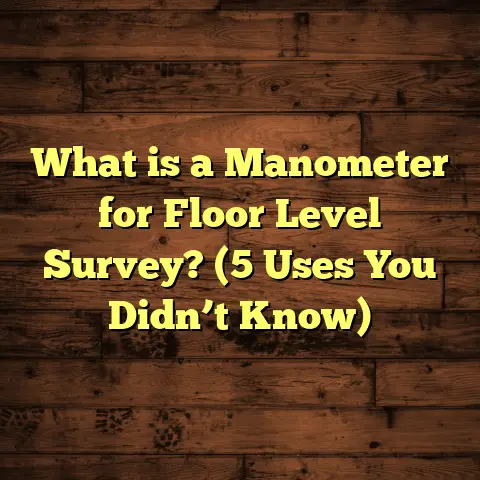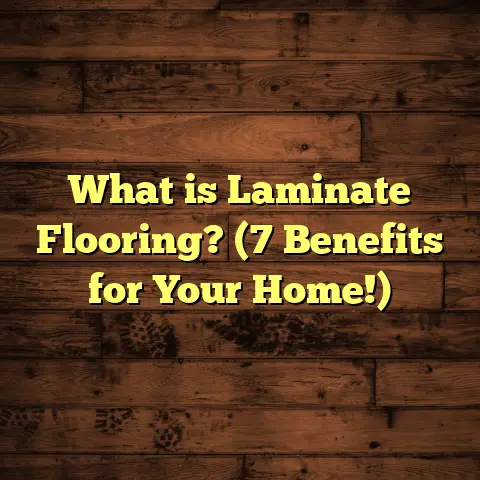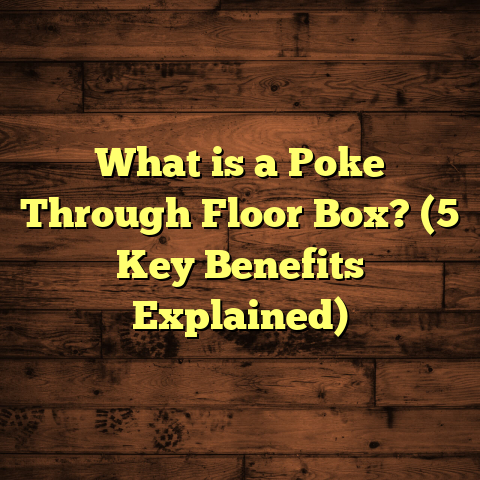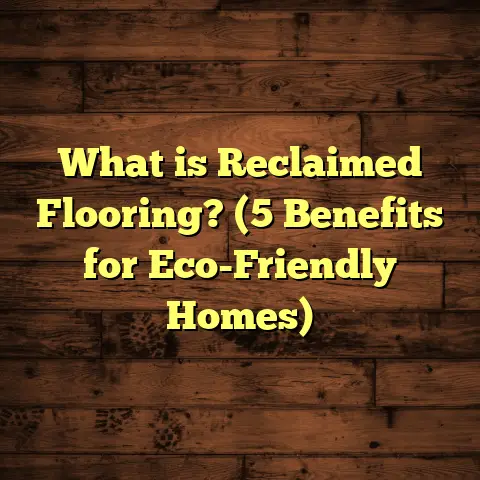What is Synthetic Flooring? (5 Key Benefits for Modern Spaces)
Imagine stepping into a sleek, modern kitchen where the floor gleams with a flawless finish and feels comfortable underfoot, almost like walking on soft clouds. Now, think about an old house I once worked on, where the wooden floorboards creaked with every step and showed cracks and scratches from years of use. The difference was striking—one floor felt like a luxury, the other a constant reminder of wear and tear. This experience made me realize how important flooring is in shaping a space’s character, comfort, and practicality. Over the years, synthetic flooring has become one of my favorite choices for modern homes and commercial spaces. It’s versatile, durable, and stylish—and today, I want to share why it might be the perfect fit for your next project.
What is Synthetic Flooring?
Synthetic flooring refers to floor coverings made from man-made materials designed to imitate or improve upon natural flooring options like hardwood, stone, or ceramic tile. These floors are manufactured using polymers such as vinyl, laminate composites, rubber, and other plastics engineered to offer durability, ease of maintenance, and visual appeal.
Unlike traditional flooring that comes directly from nature, synthetic floors are built layer by layer in factories. For example, luxury vinyl plank (LVP) flooring features a printed photographic layer that looks like wood or stone beneath a clear protective wear layer. Laminate flooring uses a fiberboard core topped with a photographic design layer sealed with melamine resin for hardness.
This technology allows synthetic floors to mimic textures and colors of natural materials closely but offer advantages such as water resistance, scratch resistance, and easier installation.
A Personal Take on Synthetic Floors
Early in my career as a flooring contractor, I was skeptical about synthetic materials. I valued the authenticity and warmth of natural hardwood floors and thought nothing could replace that charm. But time and experience changed my perspective.
One of my first major projects involved a family with young children and pets who wanted the look of hardwood but needed something that could handle spills and scratches without constant upkeep. We installed luxury vinyl plank flooring throughout their living room and kitchen. After three years, they shared how impressed they were with its durability—no scratches or water damage—and how easy it was to clean up after busy days.
That experience helped me see synthetic flooring not as a “cheap alternative,” but as a smart choice that fits many lifestyles and budgets without sacrificing style.
5 Key Benefits of Synthetic Flooring for Modern Spaces
1. Durability That Stands Up to Real Life
One of the biggest selling points I always highlight is durability. Synthetic floors are engineered to resist wear far better than some natural materials. This makes them especially suited for high-traffic areas in homes or commercial spaces.
Take luxury vinyl plank (LVP) as an example. It typically features multiple layers:
- A waterproof backing layer
- A rigid core for stability
- A high-resolution photographic layer mimicking wood or stone
- A thick wear layer that protects against scratches and stains
According to data from Floor Covering Weekly’s 2023 survey,
Luxury vinyl plank flooring can last 15 to 20 years in residential applications, even in kitchens and bathrooms where moisture is common.
Compare that to hardwood floors that often need refinishing after 10-15 years in busy areas. Synthetic floors like vinyl don’t swell or warp when wet, making them great for spaces prone to spills or humidity.
Similarly, rubber flooring products used in gyms or industrial settings resist dents and abrasions while providing slip resistance—a combination natural wood or stone can’t easily match.
2. Affordability Without Compromise
Budget plays a huge role in material choice. When clients ask me for cost-effective options that don’t look cheap, synthetic flooring often fits the bill perfectly.
Installation costs for hardwood can vary widely but generally range between $8 and $15 per square foot installed. This includes expensive finishes and labor-intensive installation processes.
On the other hand, laminate or vinyl plank flooring installations typically cost between $2 and $6 per square foot. The lower cost comes from:
- Less expensive raw materials
- Easier installation methods (many use click-lock systems)
- No need for sanding or finishing onsite
I’ve managed projects where clients wanted the warmth of wood but had tighter budgets. Synthetic floors allowed them to get the desired look without cutting corners elsewhere—whether on furniture or lighting.
3. Easy Maintenance Saves Time & Effort
Not everyone loves spending hours cleaning floors—or worse, refinishing or repairing them frequently. Synthetic floors are usually designed with low maintenance in mind.
Most require just regular sweeping or vacuuming plus occasional damp mopping with mild cleaners. Unlike hardwood or stone that may need special treatments or sealants, synthetic floors don’t demand much beyond basic cleaning.
A friend of mine installed rubber flooring in his home gym. He told me,
“I just wipe it down after workouts—no special cleaners or waxing required.”
This simplicity appeals to busy families and commercial businesses alike.
4. Design Flexibility Opens Creative Doors
If you think synthetic means “boring,” think again. Advances in printing technology have made it possible to recreate almost any look imaginable—from rustic barn wood to polished marble—at a fraction of the cost.
Manufacturers use high-definition printing layers combined with textured surfaces to simulate grain patterns, knots in wood, or stone veining.
A 2024 market report by Global Market Insights highlights,
The synthetic flooring design segment has seen a 12% annual growth rate over five years, driven by demand for realistic patterns and customizable options.
I’ve helped design office spaces with laminate floors resembling reclaimed oak planks—delivering warmth without compromising durability or budget.
5. Increasing Eco-Friendly Options
There’s a common misconception that synthetic means bad for the environment. However, many brands now focus on sustainability by:
- Using recycled materials in production
- Offering floors that are recyclable at end-of-life
- Reducing volatile organic compound (VOC) emissions during manufacture
For instance, some luxury vinyl brands incorporate recycled PVC and have take-back programs for old flooring panels.
In projects where clients prioritize green building standards like LEED certification, I often recommend certified synthetic products that meet strict environmental criteria.
Different Types of Synthetic Flooring I Recommend Regularly
The term “synthetic flooring” covers several different materials suited for various needs:
Luxury Vinyl Plank (LVP)
This has become one of my favorites for residential spaces due to its blend of style and toughness.
- Looks almost identical to hardwood but is waterproof.
- Comes with thick wear layers (up to 20 mil) for heavy use.
- Easy DIY installation with click-lock planks.
- Compatible with radiant floor heating systems.
Laminate Flooring
Laminate is a budget-friendly option for homeowners wanting wood-like aesthetics.
- Uses melamine resin for scratch resistance.
- Not waterproof but can handle occasional spills if wiped quickly.
- Available in wide variety of finishes.
- Typically lighter weight than vinyl planks.
Rubber Flooring
Commonly used in gyms or commercial kitchens where slip resistance and shock absorption matter.
- Durable against dents and abrasion.
- Easy to clean and maintain.
- Often made from recycled tires.
- Provides sound insulation benefits.
PVC Tiles
Found mostly in commercial environments but also residential basements or laundry rooms.
- Modular design allows easy replacement.
- Waterproof with good chemical resistance.
- Comes in various patterns including checkerboard or abstract designs.
Case Study: Transforming a Family Home with Vinyl Plank Flooring
About two years ago, I worked on a project that perfectly illustrates synthetic flooring’s strengths.
The client was a family of five with young children and two dogs. They wanted hardwood look floors throughout their main living areas but were worried about scratches, spills, and pet accidents ruining expensive wood.
We installed a high-end luxury vinyl plank product rated for heavy residential use with a 20 mil wear layer. Here’s what happened after one year:
- No visible scratches or dents despite active kids playing.
- Spills wiped clean instantly without staining.
- Easy routine cleaning with just a vacuum and mop.
- The family loved the warm wood look without worrying about damage.
- Installation took two days versus a week for traditional hardwood.
This project reinforced my belief that synthetic floors can combine beauty and practicality perfectly in busy homes.
Data Snapshot on Flooring Performance & Preferences
| Flooring Type | Installed Cost per Sq Ft | Expected Lifespan (Years) | Water Resistance | Maintenance Complexity | Common Usage |
|---|---|---|---|---|---|
| Hardwood | $8 – $15 | 10 – 20 | Low | Medium – High | Living rooms, bedrooms |
| Luxury Vinyl Plank | $3 – $7 | 15 – 25 | High | Low | Kitchens, bathrooms |
| Laminate | $2 – $6 | 10 – 15 | Low-Medium | Low | Bedrooms, offices |
| Rubber | $4 – $8 | 10 – 20 | High | Low | Gyms, commercial |
| PVC Tiles | $3 – $7 | 10 – 20 | High | Low | Commercial spaces |
What I Tell People Who Ask: Common Questions About Synthetic Floors
Q: Will synthetic floors feel fake underfoot?
Not necessarily! Modern vinyl planks often have textured surfaces that mimic wood grain closely. Some luxury vinyl products even have embossed finishes you can feel underfoot. Laminate tends to be harder feeling but still comfortable.
Q: Can I install synthetic flooring myself?
Many types like click-lock vinyl plank or laminate are designed for DIY installation. However, large areas or complex layouts might require professional help for best results.
Q: How do synthetic floors handle moisture?
Vinyl planks are waterproof and ideal for bathrooms or kitchens. Laminate can resist minor spills but isn’t recommended for wet areas without special waterproof cores.
Q: What about indoor air quality?
Choose low-VOC certified products to minimize off-gassing. Many brands now meet strict environmental standards.
Tips from Me for Maintaining Synthetic Flooring
Keeping your synthetic floor looking great doesn’t have to be hard:
- Sweep or vacuum regularly to remove dirt and grit.
- Use a damp mop with mild soap designed for vinyl or laminate floors.
- Avoid abrasive cleaners or wax-based products.
- Clean spills immediately to prevent staining.
- Use felt pads under furniture legs to prevent scratches.
- Follow manufacturer recommendations on cleaning products.
More Stories from My Work With Synthetic Floors
I once installed rubber flooring in a local yoga studio. The owners loved how the material cushioned joints during practice while holding up well to moisture from mats being cleaned daily. After six months, there was zero wear where foot traffic was highest—a problem they had faced with previous carpet tiles.
Another project involved outfitting an art gallery with PVC tiles laid in bold geometric patterns. The client wanted durability but also an artistic edge on the floor itself. Synthetic flooring allowed them endless freedom in design while meeting practical needs like stain resistance from spilled paint or glue.
Looking Ahead: Trends in Synthetic Flooring
The market continues evolving rapidly:
- Thinner yet stronger wear layers improving longevity.
- More eco-friendly materials made from bio-based polymers.
- Enhanced textures that replicate exotic woods and stones.
- Smart flooring embedded with sensors for commercial buildings.
- Wider plank sizes mimicking architectural trends in hardwood design.
For people thinking about remodeling or designing new spaces today, synthetic flooring offers flexibility unmatched by many traditional materials.
Final Thoughts from Me
I’ve seen firsthand how synthetic flooring can transform spaces—from busy family homes to professional offices—by delivering style without stress over damage or maintenance costs. The combination of durability, affordability, easy care, design options, and growing sustainability make it an excellent choice that fits modern lifestyles.
If you’re weighing your flooring options right now, consider what your space really needs day-to-day—and how much time you want to spend caring for your floors over the years. Synthetic materials often give you peace of mind without compromising beauty.
Got questions about specific products or how to pick the right synthetic floor? Just ask—I’m happy to help you find the best fit based on your project’s unique needs!





